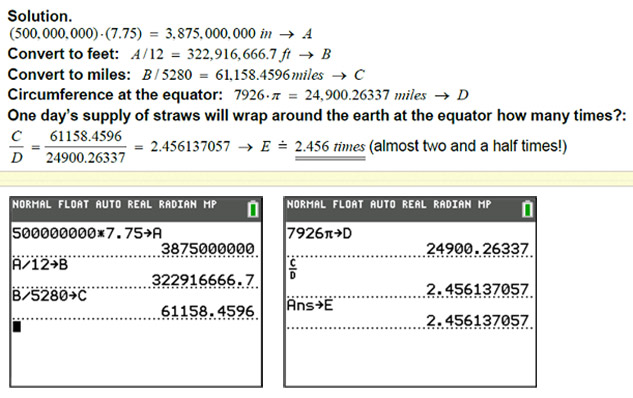Engage Students With This Real-World Earth Day Activity
How many straws are used in the U.S. every day? If they were connected, would they wrap around the Earth at the equator? If so, how many times? In one year, would the length of straws reach the moon? What is the volume of this plastic for one year? How deep would it be on a football field? The answers to these questions will astound you!
In the Earth Day activity below, we’ll use math to help students answer important questions about societal issues like plastic pollution and the environment. You’ll investigate these real-world questions using applied mathematics, unit conversion, geometry and problem-solving.
And, by the way, the answer to the first question above is 500 million! Yes, 500,000,000 straws are used in the U.S. every single day, according to an article in the April 15, 2018 edition of Parade magazine. This activity will help put that number into context.
Let’s get started: If the straws are connected, how many times would they wrap around the Earth at the equator? To solve this question, ask students to collaborate in groups of three or four. This can be done via phone, email or videoconference.
The first thing we expect students to do is to decide what information they need to know and ask in order to answer this question (and others). Why do it this way? By asking for the necessary information, students have already begun to solve the problem. Students should ask these questions:
- What straw length should be used?
- What is the radius, diameter or circumference of the Earth?
If students ask questions that are not necessary to ask as part of the solution, we suggest you provide answers where possible. Don’t reply, “Oh, you don’t need to know that.” If the students fail to ask the necessary questions, should we supply that information anyway? We don’t recommend that. Eventually students will ask for the necessary information. We want this to be as close to a real-world application problem as possible. Also, we strongly encourage the use of calculators and the practice of storing intermediate values into different variables, as well as not rounding any number until the final answer.
Here is an example of the solution to the question, “A day’s supply of straws in the U.S. will wrap around the Earth at the equator how many times?”
Using the average straw length of 7 3/4 inches and the diameter of the earth as 7,926 miles, calculate the answer using these steps:

You can find the student sheets, teacher notes, a video to use with students who are “working from home,” and a video for teachers to help with the solutions at bit.ly/plastraw. Additional resources and background information for this activity are available at bit.ly/plasticstraw2020.
In addition, you can watch a webinar that takes you through the activity using Texas Instruments (TI) graphing calculators.
About the author: Tom Reardon has taught mathematics in Ohio at Fitch High School for 35 years and part time at Youngstown State University for 39 years. As a T³™ National Instructor, Tom provides professional development internationally, and he serves as an advisor to TI product strategy and development. www.TomReardon.com
Tagcloud
Archive
- 2025
- 2024
- 2023
- 2022
-
2021
- January (2)
- February (3)
- March (5)
-
April (7)
- Top Tips for Tackling the SAT® with the TI-84 Plus CE
- Monday Night Calculus With Steve Kokoska and Tom Dick
- Which TI Calculator for the SAT® and Why?
- Top Tips From a Math Teacher for Taking the Online AP® Exam
- Celebrate National Robotics Week With Supervised Teardowns
- How To Use the TI-84 Plus Family of Graphing Calculators To Succeed on the ACT®
- AP® Statistics: 6 Math Functions You Must Know for the TI-84 Plus
- May (1)
- June (3)
- July (2)
- August (5)
- September (2)
-
October (4)
- Transformation Graphing — the Families of Functions Modular Video Series to the Rescue!
- Top 3 Halloween-Themed Classroom Activities
- In Honor of National Chemistry Week, 5 “Organic” Ways to Incorporate TI Technology Into Chemistry Class
- 5 Spook-tacular Ways to Bring the Halloween “Spirits” Into Your Classroom
- November (4)
- December (1)
-
2020
- January (2)
- February (1)
- March (3)
- April (1)
- May (2)
- July (1)
- August (2)
- September (3)
-
October (7)
- Tips for Teachers in the time of COVID-19
- Top 10 Features of TI-84 Plus for Taking the ACT®
- TI Codes Contest Winners Revealed
- Best of Chemistry Activities for the Fall Semester
- Best of Biology Activities for the Fall Semester
- Best of Physics Activities for the Fall Semester
- Best of Middle Grades Science Activities
- November (1)
- December (2)
- 2019
-
2018
- January (1)
- February (5)
- March (4)
- April (5)
- May (4)
- June (4)
- July (4)
- August (4)
- September (5)
-
October (9)
- Art in Chemistry
- Which Texas Instruments (TI) Calculator for the ACT® and Why?
- Meet TI Teacher of the Month: Jessica Kohout
- Innovation in Biology
- Learning With Your Students
- A first-of-its-kind STEM strategy charts path to help educators
- #NCTMregionals Hartford 2018 Recap
- The Math Behind “Going Viral”
- Real-World Applications of Chemistry
-
November (8)
- Testing Tips: Using Calculators on Class Assessments
- Girls in STEM: A Personal Perspective
- 5 Teachers You Should Be Following on Instagram Right Now
- Meet TI Teacher of the Month: Katie England
- End-of-Marking Period Feedback Is a Two-Way Street
- #NCTMregionals Kansas City 2018 Recap
- Slope: It Shouldn’t Just Be a Formula
- Hit a high note exploring the math behind music
- December (5)
- 2017
- 2016
- 2015
